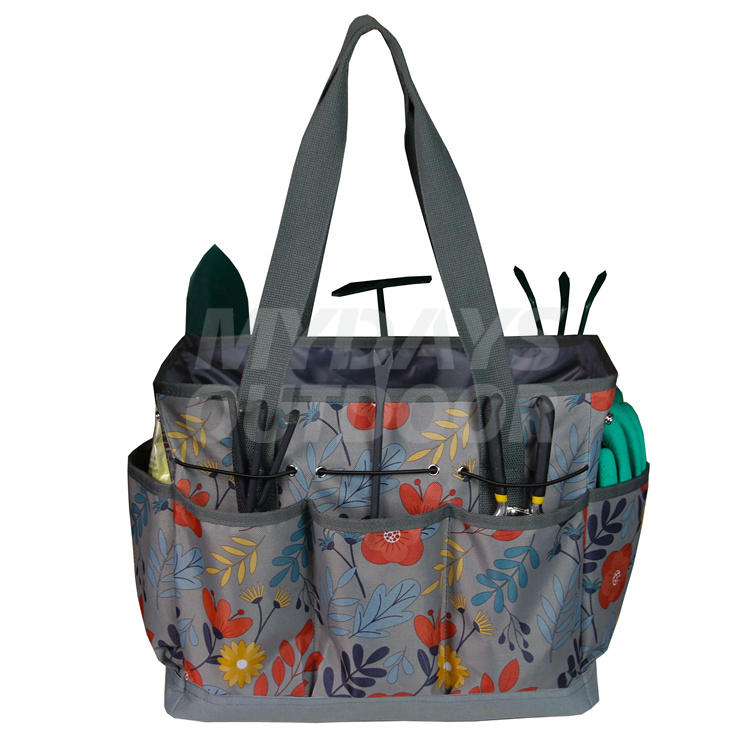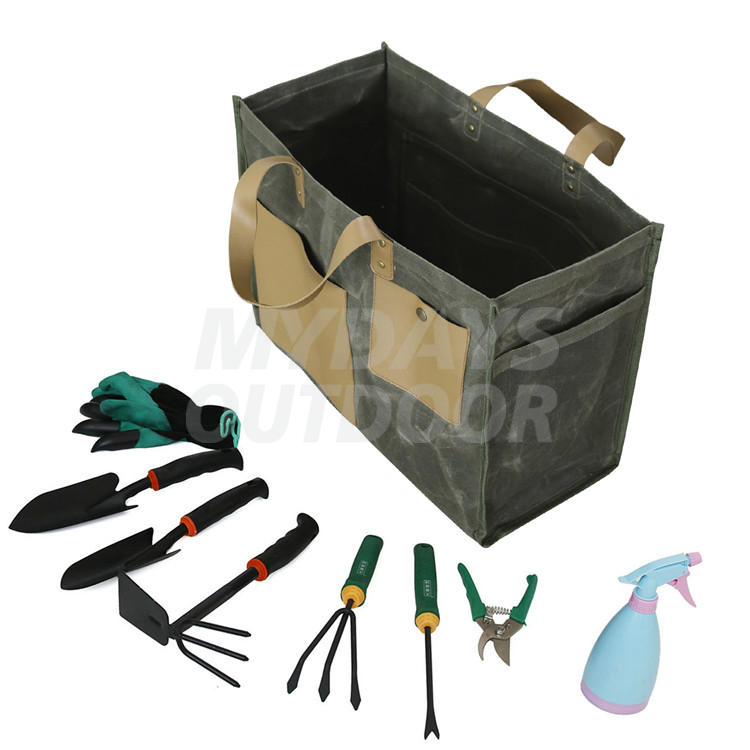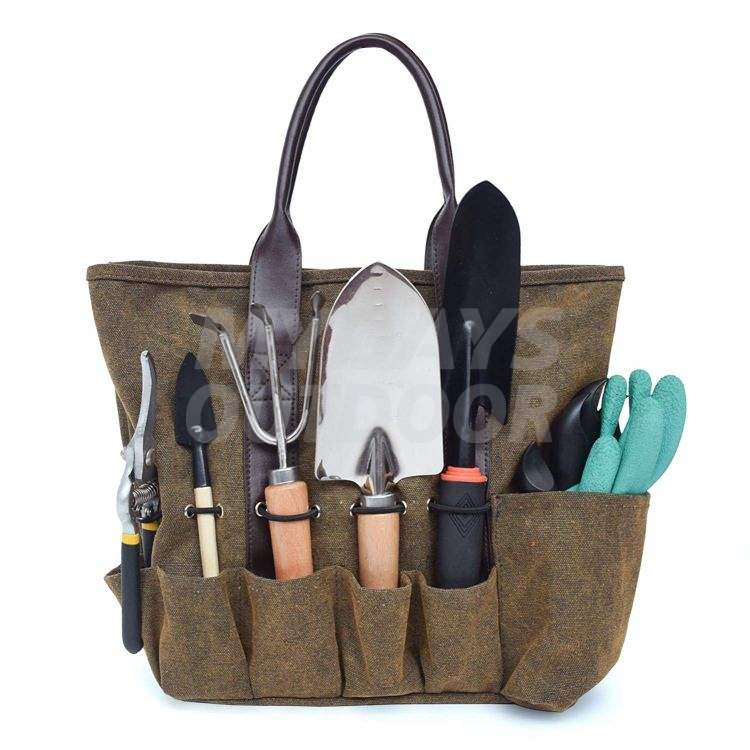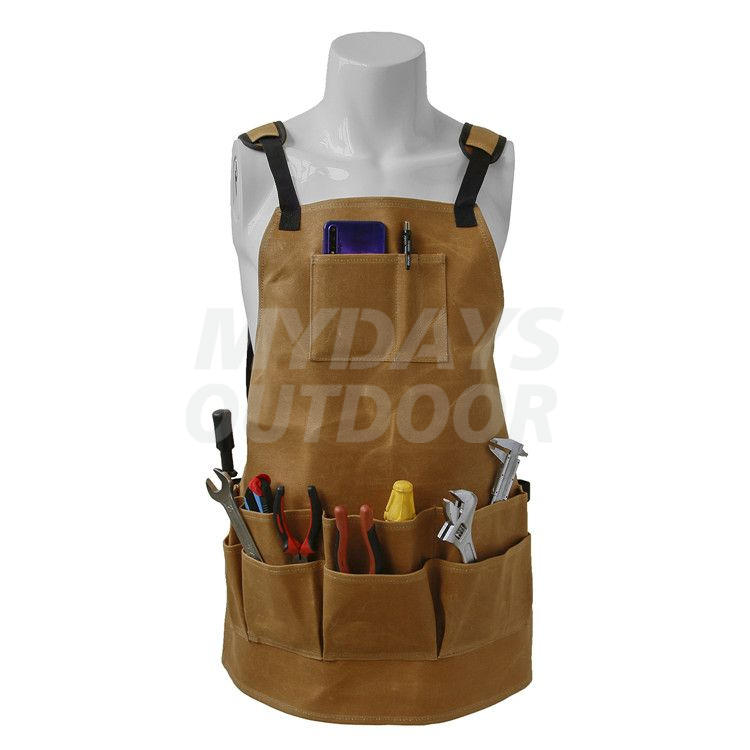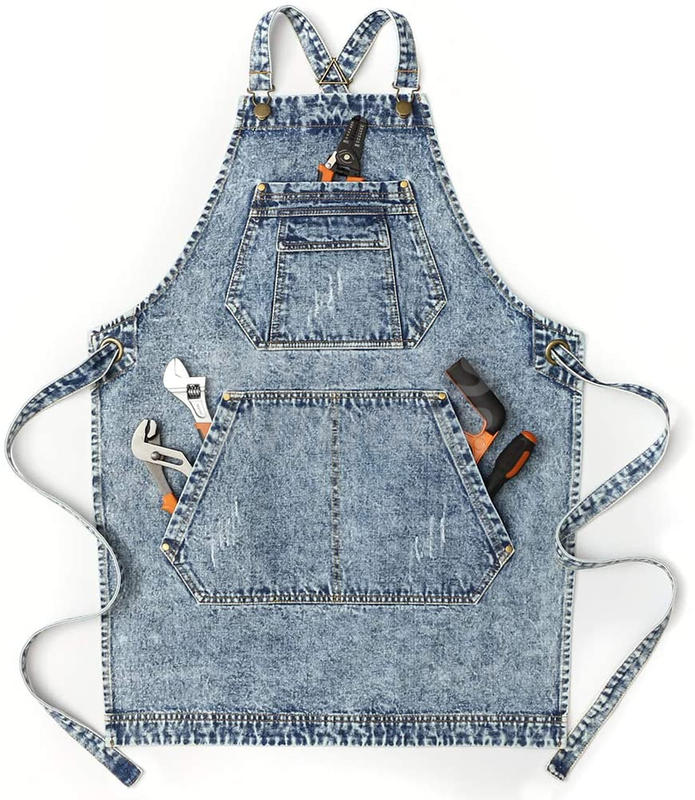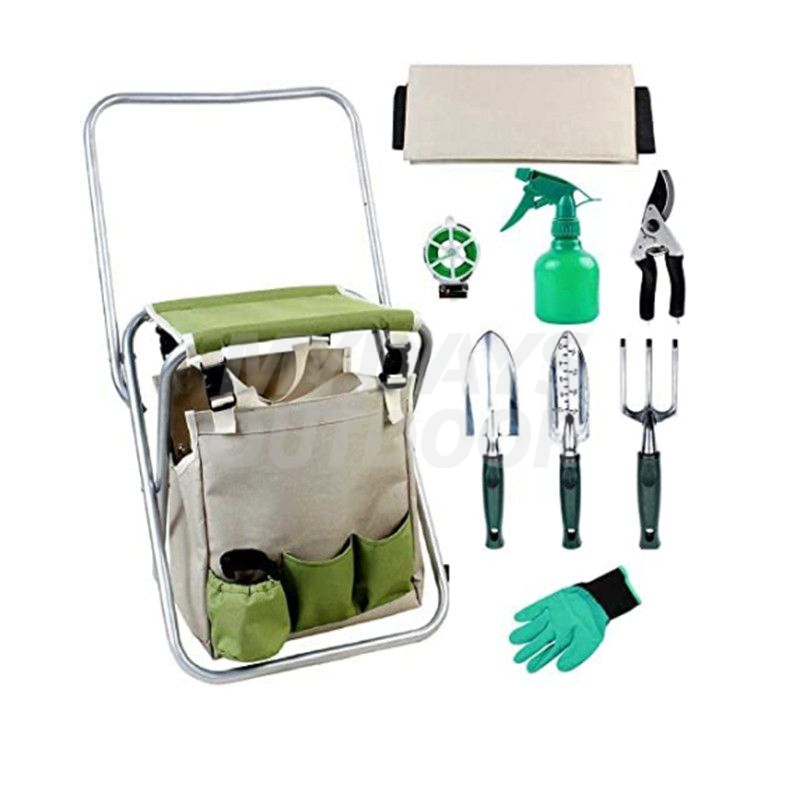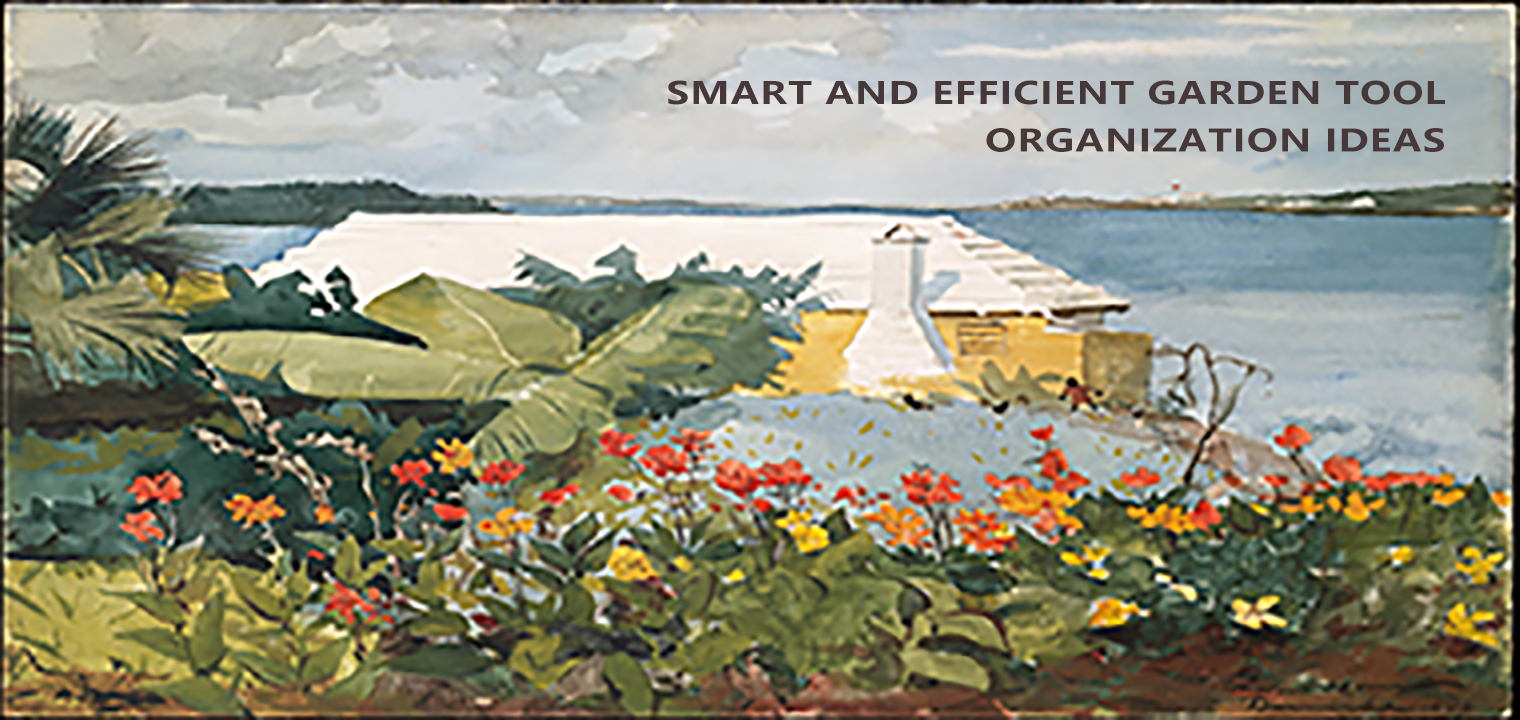
Are you tired of constantly searching for your garden tools when you need them? Do you find yourself spending more time looking for your gardening equipment than actually working in your garden? If so, it's time to get your garden tools organized and create a space where everything is easily accessible. In this article, we will explore smart and efficient garden tool organization ideas that will help you streamline your gardening activities and make the most of your time outdoors.
Introduction
A well-organized garden tool area can significantly enhance your gardening experience. When your tools are neatly arranged and easily accessible, you can save valuable time and effort while working in your garden. Moreover, proper organization helps protect your tools from damage and rust, extending their lifespan. In the following sections, we will explore a range of garden tool organization ideas that will assist you in creating an efficient and functional space for your gardening tools.
Tool Shed or Storage Space:
If you have a garden shed or designated storage area, it's beneficial to allocate specific sections or shelves for different categories of tools. Utilize hooks, racks, or pegboards to hang larger tools such as shovels, rakes, and hoes. Consider using shelves or bins to store smaller tools like hand trowels, pruners, and gloves. By grouping similar tools together, you can easily locate and retrieve them when needed.
Wall-Mounted Storage Solutions:
If space is limited or you lack a dedicated shed, make the most of your garage or outdoor walls by installing wall-mounted tool storage. Sturdy hooks, racks, or tool organizers can be affixed to these walls to hang and store your garden tools. This not only keeps them off the floor but also ensures visibility and easy access.
Tool Racks or Carts:
Investing in a tool rack or cart designed specifically for garden tools can be highly beneficial. These portable storage solutions often feature slots or compartments to securely hold various tools. Equipped with wheels or handles, they can be easily maneuvered around your garden, keeping your tools within arm's reach throughout your gardening tasks.
Magnetic Strips:
Magnetic strips or bars offer an efficient way to organize metal hand tools. By affixing the magnetic strip to a wall or the interior of a cabinet, you can magnetically attach your metal tools, ensuring they remain neatly organized and readily accessible. This option works exceptionally well for small tools like pruners, scissors, or metal hooks.
Tool Belts or Aprons:
Tool belts or aprons equipped with multiple pockets are practical choices for keeping your essential hand tools close while working in the garden. These wearable organizers enable you to carry your tools conveniently, saving time and minimizing the risk of misplacing them.
Vertical Storage:
Maximize vertical space utilization by installing hooks or hangers on the back of doors or inside cabinets. This approach proves effective for storing smaller hand tools, gloves, or even seed packets. By hanging your tools vertically, you optimize space usage, while simultaneously ensuring easy visibility and access.
Labeled Containers or Bins:
Opt for labeled containers or bins to store smaller gardening items like seeds, bulbs, plant markers, and fertilizers. Transparent and stackable containers are ideal, as they enable easy identification of contents. Consider grouping similar items together and labeling each container to establish an organized and efficient system.
Garden Tool Organizers:
Investing in garden tool organizers designed to accommodate various tool types can greatly simplify your storage needs. These organizers often feature slots or compartments to secure long-handled tools, alongside smaller pockets or hooks for hand tools. Whether freestanding or wall-mounted, they provide a compact and convenient storage solution for your garden tools.
Remember, an effective garden tool organization system is one that suits your specific requirements and preferences. After each use, ensure your tools are well-maintained and cleaned before returning them to their designated spots, guaranteeing easy accessibility for future gardening tasks. Regularly reassess your organization system and make necessary adjustments to accommodate new tools or changes in your gardening routine.
By establishing a well-organized garden tool area, you will spend less time searching for your equipment and more time enjoying the pleasures of gardening. Implement these organization ideas, create a clutter-free space, and optimize your gardening activities with efficient tool management. Embrace the benefits of a well-organized garden tool area and revel in a more enjoyable and productive gardening experience.
The Importance of Garden Tool Organization
Having an organized garden tool area provides numerous advantages that can greatly enhance your gardening experience. Firstly, it saves you valuable time and frustration by eliminating the need to search for specific tools when you need them. With a well-organized system in place, you can easily locate the tools required for each gardening task, ensuring a smooth and efficient workflow. No more wasted time rummaging through cluttered spaces or forgetting where you last placed a tool.
Secondly, an organized tool area helps reduce the risk of accidents and injuries. By properly storing sharp or dangerous tools, such as pruning shears, saws, or hedge trimmers, you create a safer environment, especially if you have children or pets around. Tools kept in designated spots or secured in storage solutions minimize the chances of accidental cuts, falls, or other mishaps that could result from loose tools lying around.
Furthermore, an organized garden tool area contributes to the longevity of your tools. When tools are left exposed to the elements or stored haphazardly, they are prone to rust, corrosion, and other forms of damage. By providing a dedicated storage space, you protect your tools from moisture, extreme temperatures, and other detrimental factors. Properly cleaning and drying your tools before storage also helps prevent rust formation and maintains their functionality over time. By extending the lifespan of your tools, you save money on frequent replacements and ensure that your equipment remains in excellent working condition.
Moreover, an organized tool area promotes efficient maintenance practices. When your tools are readily accessible and visible, you're more likely to remember to perform routine maintenance tasks such as oiling, sharpening, or tightening loose parts. Regular maintenance not only ensures the optimal performance of your tools but also enhances their durability, saving you from unexpected breakdowns or malfunctions during critical gardening moments.
An additional benefit of an organized tool area is the psychological impact it has on your overall gardening experience. A clean and clutter-free space creates a sense of calm and order, allowing you to focus on the joy of gardening rather than feeling overwhelmed by the chaos of disorganization. It fosters a positive mindset and encourages you to engage in more frequent gardening activities.
To create an organized garden tool area, assess your available space and consider the various organization options mentioned earlier, such as tool sheds, wall-mounted storage, or tool racks. Customize your storage solutions to fit the size and quantity of your tools, and regularly review and adjust your system as your tool collection evolves. Use labels or color-coding to further enhance organization and simplify tool identification.
By investing the time and effort in creating an organized garden tool area, you will reap the rewards of improved efficiency, safety, and tool longevity. Enjoy the convenience of having your tools readily accessible, the peace of mind that comes with a safer gardening environment, and the satisfaction of preserving your tools for years to come. Embrace the benefits of organization and make your gardening endeavors even more rewarding.
Assessing Your Gardening Needs
Before embarking on the task of organizing your garden tools, it's essential to take a moment to assess your specific gardening needs. By considering the types of tools you use most frequently and evaluating the amount of storage space required, you can determine the most suitable organization methods that will cater to your unique requirements.
Begin by examining your gardening routine and identifying the tools that are indispensable for your tasks. These may include hand tools like trowels, pruners, and cultivators, as well as larger tools such as shovels, rakes, and wheelbarrows. Take note of the tools that are used regularly versus those that are used occasionally or seasonally. Understanding the tools that you rely on most will help you prioritize their accessibility and storage.
Next, evaluate the amount of storage space available to you. This may include a garden shed, a garage, a dedicated tool area, or even a corner in your yard. Take measurements and consider the dimensions of the space. This will enable you to assess the capacity for different storage solutions and guide you in selecting appropriate organizing methods.
Once you have a clear understanding of your gardening needs and available space, you can determine the most suitable organization methods. Consider the various options discussed earlier, such as tool sheds, wall-mounted storage, tool racks, or portable tool carts. Each method offers distinct advantages, depending on your specific situation. For instance, if you have limited space, wall-mounted storage or vertical tool racks may be ideal for maximizing the use of vertical space. On the other hand, if you require portability and flexibility, a tool cart or a combination of tool bags and belts might be more suitable.
Remember to factor in future growth or changes in your tool collection. Leave room for expansion and consider scalability in your chosen organization system. This will ensure that your storage solution remains effective as your gardening needs evolve.
By taking the time to assess your gardening needs and storage requirements, you can make informed decisions when it comes to organizing your garden tools. This thoughtful approach will save you from the frustration of ineffective storage solutions and enable you to create an organized space that supports your gardening activities seamlessly. So, begin with a thorough evaluation, plan accordingly, and embark on your journey to a well-organized and efficient garden tool area.
Designing a Functional Tool Storage Area
To establish an efficient tool storage area, it is crucial to designate a specific space solely for your garden tools. Ideally, this area should be in close proximity to your garden or outdoor workspace to ensure easy and convenient access. There are several options to consider when choosing the right organizational solutions for your garden tools, depending on the available space and your personal preferences.
Garden Shed:
If you have the luxury of a garden shed, it is an ideal space to store and organize your tools. Install shelves, hooks, or racks on the walls to hang larger tools such as shovels, rakes, and hoes. Use bins, containers, or drawers to store smaller tools, gardening gloves, and accessories. Consider labeling each section or using color-coding to quickly identify and locate specific tools.
Garage or Storage Room:
If you don't have a garden shed, utilizing a corner or wall in your garage or storage room can be an excellent alternative. Install wall-mounted tool organizers, pegboards, or shelving units to create dedicated spaces for each tool. Ensure that the chosen area is well-ventilated and protected from moisture to prevent rust or damage to your tools.
Outdoor Tool Rack or Stand:
If you prefer to keep your tools outdoors, invest in a sturdy and weather-resistant tool rack or stand. These freestanding structures often have multiple slots or hooks to accommodate various tools. Place it near your garden or in a designated spot to ensure quick access and protection from the elements.
Tool Cabinet or Toolbox: For a more compact solution, consider using a tool cabinet or toolbox. These storage options are beneficial if you have a smaller tool collection or if you frequently transport your tools to different locations. Choose a cabinet or toolbox with multiple compartments and drawers to keep your tools organized and protected during storage and transportation.
Wall-Mounted Storage Solutions:
Utilize available wall space to mount tool racks, hooks, or pegboards. These can be installed in your shed, garage, or even on the exterior walls of your house. Arrange your tools systematically, grouping similar items together for easy access and a visually pleasing display. This method maximizes vertical space and keeps your tools visible and within reach.
Portable Tool Carts or Tool Bags:
If you prefer mobility or if you frequently work in different areas of your garden, consider using a tool cart or tool bag. These options allow you to organize your tools and easily transport them as needed. Tool carts typically have multiple compartments, shelves, and wheels, while tool bags offer various pockets and compartments for specific tools.
When organizing your tools, prioritize accessibility and safety. Keep frequently used tools within arm's reach, and ensure that sharp or dangerous tools are properly stored to avoid accidents. Additionally, clean and dry your tools before storing them to prevent rust and prolong their lifespan.
By designating a specific space for your garden tools and utilizing appropriate organizational solutions, you can create an efficient and well-organized storage area. This will not only save you time and frustration but also protect your tools, making them readily available whenever you need them. Enjoy the convenience and functionality of a well-designed tool storage area, and make your gardening experiences more enjoyable and productive.
Hanging Storage Solutions
Hanging storage solutions are a highly popular choice for organizing garden tools, as they offer convenience, accessibility, and space optimization. By utilizing hooks, rails, and clips, you can keep your tools off the ground, prevent clutter, and ensure easy reachability. There are various options available for implementing hanging storage in your garden tool organization system.
Wall Hooks: Install hooks on walls or a designated board to hang your larger tools such as rakes, shovels, and hoes. Choose sturdy hooks that can support the weight of your tools securely. Arrange the hooks in a way that keeps the tools organized and easily accessible. You can group similar tools together or arrange them based on size and usage frequency.
Rails and Track Systems: Rails and track systems offer versatility and flexibility in hanging your garden tools. These systems typically consist of a metal rail or track that can be mounted on walls or the inside of a shed or garage. Attach hooks, clips, or holders to the rail or track to hang your tools. The adjustable nature of these systems allows you to customize the spacing and arrangement of the hooks to accommodate different tools.
Pegboards: Pegboards are a versatile and customizable option for creating a hanging storage system for your garden tools. These boards have evenly spaced holes, into which you can insert pegboard hooks or clips. Arrange the hooks to match the shape and size of your tools, allowing for easy organization and customization. Pegboards can be mounted on walls or the interior of a shed, offering a visually appealing and accessible storage solution.
Tool Racks: Tool racks specifically designed for hanging storage are available in various sizes and configurations. These racks often feature multiple hooks or slots that accommodate different tools. Some racks also have additional shelves or compartments to store smaller items. Tool racks can be freestanding or mounted on walls, depending on your space and preference.
When utilizing hanging storage solutions, consider the weight and size of your tools. Ensure that the hooks or clips you choose are strong and durable enough to support the tools without any risk of falling. Group similar tools together to keep them organized and make it easier to locate specific items when needed.
By implementing hanging storage solutions, you can maximize the use of vertical space, keep your tools within reach, and create a clean and organized garden tool area. This approach not only helps in decluttering your gardening space but also extends the lifespan of your tools by keeping them off the ground and protected from damage. Embrace the convenience and efficiency of hanging storage, and enjoy a well-organized garden tool area that simplifies your gardening tasks.
Wall-Mounted Racks and Pegboards
Wall-mounted racks and pegboards are versatile and practical options for organizing your garden tools. By installing sturdy racks or pegboards on your walls, you can create a designated space to hang and store your tools, maximizing vertical space and ensuring easy accessibility. These methods allow you to arrange tools of different sizes and shapes in an organized and visually pleasing manner.
Wall-mounted racks provide sturdy support for hanging tools. You can choose from a variety of options, such as metal or plastic racks with hooks or slots specifically designed for garden tools. Install the rack securely on the wall, ensuring it can withstand the weight of your tools. Arrange the tools on the rack according to their sizes, grouping similar items together. Larger tools like rakes and shovels can be placed on the rack's hooks or slots, while smaller tools such as hand trowels and pruners can be hung using smaller hooks. This arrangement not only keeps your tools organized but also allows you to quickly locate the specific tool you need.
Pegboards are another versatile solution for wall-mounted tool organization. These boards have evenly spaced holes, into which you can insert hooks, clips, or holders. Choose sturdy pegboard hooks or clips that can securely hold your tools. Arrange the hooks or clips on the pegboard according to the shapes and sizes of your tools. Larger tools can be hung directly on the hooks, while smaller tools can be placed in holders or attached using clips. The flexibility of pegboards allows you to customize the arrangement to suit your specific needs and easily adjust it as your tool collection evolves.
Both wall-mounted racks and pegboards offer the advantage of utilizing vertical space effectively, freeing up valuable floor space and reducing clutter. They also provide a clear view of your tools, making it easier to find and access the tool you need for a particular gardening task. Additionally, by hanging your tools on the wall, you help protect them from damage, such as bending, dulling, or getting lost amidst other items.
When installing racks or pegboards, ensure they are securely mounted on the wall, following the manufacturer's instructions. Use appropriate hardware and check that the installation is stable and able to support the weight of your tools.
By utilizing wall-mounted racks or pegboards, you can create an organized and efficient garden tool storage area. Enjoy the benefits of easy accessibility, maximized vertical space, and a visually pleasing display of your tools. With a well-organized tool area, you'll be able to quickly find the right tool for any gardening task, making your gardening experience more enjoyable and productive.
Utilizing Shelves and Cabinets
Shelves and cabinets are excellent solutions for organizing smaller gardening tools, pots, and other accessories. When it comes to storing items like gloves, watering cans, seed packets, and plant labels, installing sturdy shelves in your storage area can provide a neat and efficient arrangement. Consider incorporating cabinets with doors to protect your tools from dust and moisture, ensuring their longevity.
Shelves are a versatile option for organizing smaller gardening tools and accessories. Install shelves of appropriate size and strength, ensuring they are securely mounted to support the weight of your items. Group similar items together and designate specific shelves for different categories of tools or accessories. For example, you can dedicate one shelf for gloves, another for seed packets, and a separate one for watering cans or small pots. Utilize storage bins, baskets, or dividers on the shelves to further compartmentalize and keep items organized.
Cabinets with doors offer additional benefits by providing a protective enclosure for your tools. These cabinets can be freestanding or mounted on the wall, depending on your available space and preferences. Choose cabinets made of durable materials, resistant to moisture and humidity. By storing your tools behind closed doors, you can keep them shielded from dust, dirt, and potential water damage. Cabinets often come with adjustable shelves, allowing you to customize the interior space based on the size and quantity of your tools. Consider labeling the cabinet doors or using transparent containers within the cabinets for easy identification of the tools and accessories stored inside.
When organizing your tools on shelves or inside cabinets, arrange them in a logical and systematic manner. Store frequently used items within easy reach, and place lesser-used items on higher or lower shelves. This arrangement ensures that you can quickly locate the tools you need for specific gardening tasks.
Remember to keep your shelves and cabinets clean and well-maintained. Regularly remove any dust or debris that may accumulate, and periodically assess the organization system to make any necessary adjustments as your tool collection expands or changes.
By utilizing shelves and cabinets in your storage area, you can create an organized and protected space for your smaller gardening tools, pots, and accessories. This approach not only helps declutter your gardening space but also extends the lifespan of your tools by keeping them in a clean and controlled environment. Enjoy the convenience and functionality of shelves and cabinets, and make your gardening endeavors more efficient and enjoyable.
Portable Tool Caddies and Carts
If you prefer to have your tools readily available as you move around your garden, portable tool caddies and carts are an excellent solution. These mobile storage options offer the convenience of easily transporting your tools while keeping them organized and accessible. When choosing a tool caddy or cart, look for features such as multiple compartments and sturdy wheels for smooth movement.
Portable tool caddies and carts are designed to provide a compact and organized storage solution for your gardening tools. They typically feature compartments, dividers, or slots specifically designed to accommodate different types of tools. You can find models with various sizes and configurations, allowing you to choose the one that best suits your needs.
When selecting a tool caddy or cart, consider the size and quantity of tools you typically use in your gardening activities. Look for one with ample space to accommodate your tools comfortably. Consider compartments or pockets that are suitable for different tool sizes, ensuring a secure fit and easy retrieval. Some caddies may even have additional space for storing items like gloves, seeds, or small accessories.
Sturdy wheels are an essential feature to consider in a portable tool caddy or cart. Opt for models with durable and reliable wheels that can handle various terrains in your garden, such as grass, gravel, or pavement. This will enable smooth movement and make it easier for you to transport your tools wherever you need them.
Another aspect to consider is the overall build quality and durability of the tool caddy or cart. Choose a product made of sturdy materials that can withstand the demands of outdoor use. Look for reinforced handles, solid construction, and weather-resistant features to ensure longevity.
To maximize the benefits of a portable tool caddy or cart, establish an organization system that works for you. Arrange your tools in a way that allows for easy access and efficient use. Keep frequently used tools within reach, and consider grouping similar items together to further enhance organization.
By utilizing a portable tool caddy or cart, you can keep your gardening tools organized and conveniently transport them as you move around your garden. This mobility eliminates the need to constantly return to a fixed storage area, saving you time and effort. Enjoy the convenience and efficiency of a portable tool storage solution, and make your gardening experience more enjoyable and productive.
Garden Shed or Storage Container
If you have a larger collection of garden tools, it may be worthwhile to invest in a garden shed or storage container. These structures provide ample space for organization and offer protection against the elements. By installing shelves, hooks, and racks within the shed, you can create a systematic storage solution for your tools and equipment.
A garden shed or storage container provides a dedicated space to store and organize your garden tools. These structures come in various sizes and designs to accommodate different needs and preferences. When selecting a shed or storage container, consider the size of your tool collection and choose one that offers enough space to house all your tools comfortably.
Once you have a garden shed or storage container, it's time to customize the interior for efficient tool organization. Install shelves along the walls to maximize vertical space and create multiple levels for storing tools. Sturdy metal or wooden shelves can hold larger tools such as shovels, rakes, and hoes, while smaller items like hand trowels, pruners, and gloves can be placed on shelves or in bins.
Utilize hooks, racks, or pegboards on the walls to hang tools with long handles, such as shovels, rakes, and brooms. This helps keep them off the ground, prevents damage, and makes them easily accessible. Consider grouping similar tools together or arranging them based on usage frequency to further streamline organization.
To make the most of the shed's space, use stackable storage containers or bins for smaller tools, seeds, fertilizers, and other gardening supplies. Label each container to quickly identify its contents and maintain an organized system.
Ensure that your garden shed or storage container is secure and weatherproof. This will protect your tools and equipment from moisture, pests, and other potential damage. Regularly inspect the shed for any signs of wear or damage, and make necessary repairs or maintenance to keep it in optimal condition.
By investing in a garden shed or storage container and customizing the interior with shelves, hooks, and racks, you can create a systematic storage solution for your garden tools. This allows you to keep your tools organized, protected, and easily accessible. Enjoy the benefits of a well-organized tool storage area, and make your gardening activities more efficient and enjoyable.
Labeling and Categorizing Tools
To take your garden tool organization to the next level, consider implementing labeling and categorization methods. By labeling your tools and categorizing them into groups, you can enhance organization and make it easier to locate specific tools when needed. Here are some tips to help you with this process:
Labeling Tools: Use waterproof labels or permanent markers to label each tool with its name or purpose. This can be especially helpful for tools that may look similar at first glance. Labeling ensures that you can quickly identify the tool you need without confusion. For example, label your trowels, shovels, or pruners with their respective names. You can affix the labels directly to the tools or use tags attached to the tool handles.
Categorizing Tools: Categorize your tools into groups based on their functions or usage. For example, you can have separate categories for digging tools, pruning tools, watering tools, and so on. This categorization system allows you to easily locate tools within specific groups. You can dedicate specific areas in your storage space, such as shelves or sections in a tool rack, for each category. This way, you know exactly where to find the tool you need based on its category.
Color-Coding: Another option is to color-code your tools. Assign specific colors to different categories or types of tools. For example, you could use blue for digging tools, green for pruning tools, and red for watering tools. This visual coding system provides an immediate visual cue, making it even easier to identify and retrieve the desired tool quickly.
Tool Identification Chart: Create a tool identification chart that lists all the tools you have along with their corresponding names or purposes. This can be a simple document or a laminated sheet that you keep in your garden shed or near your tool storage area. The chart serves as a reference guide, especially if you have a large tool collection or if you frequently acquire new tools. It helps you quickly identify the tools you need based on their names or descriptions.
By implementing labeling and categorization techniques, you streamline the process of finding and retrieving specific tools from your collection. This system saves you time and minimizes frustration, allowing you to focus more on your gardening tasks.
Remember to regularly review and update your labels and categories as your tool collection evolves. Consider making adjustments based on new tools you acquire or changes in your gardening practices.
With a well-labeled and categorized tool collection, you'll have a more organized and efficient gardening experience. Enjoy the benefits of easy tool identification and retrieval, and make the most of your gardening endeavors.
Maintenance and Cleaning Tips
Organizing your garden tools is not only about storage but also about ensuring their longevity and optimal performance. Proper maintenance and cleaning are crucial aspects of tool care. By regularly inspecting your tools, cleaning them after use, and performing necessary maintenance tasks, you can keep your tools in excellent condition. Here are some steps to follow:
Regular Inspection: Take the time to inspect your tools regularly, especially before and after each use. Look for signs of damage, such as rust, cracks, or bent parts. Check the handles for any splintering or loosening. Inspecting your tools allows you to address any issues promptly and prevent further damage.
Cleaning: After each use, make it a habit to clean your tools. Remove any dirt, debris, or plant matter that may have accumulated on the surfaces. Use a brush or a cloth to wipe away dirt and rinse tools with water if necessary. Pay attention to areas where dirt tends to collect, such as the crevices of handles or the teeth of pruning shears. Dry your tools thoroughly to prevent moisture buildup, which can lead to rust.
Rust Prevention: Rust is a common enemy of garden tools. To prevent rust, ensure your tools are completely dry after cleaning. If you notice any signs of rust, gently scrub the affected areas with a wire brush or abrasive pad. Applying a thin coat of oil or lubricant, such as WD-40, can also help protect against rust. Be sure to wipe off any excess oil before using the tools again.
Blade Maintenance: If your tools have blades, such as pruners or shears, it's important to keep them sharp. Dull blades can make tasks more difficult and can potentially damage plants. Use a sharpening tool or a sharpening stone to maintain a sharp edge on the blades. Follow the manufacturer's instructions or seek guidance from a professional if you're unsure about the proper sharpening technique for your specific tools.
Lubrication: Moving parts, such as hinges or pivots, may benefit from occasional lubrication. Apply a small amount of lubricating oil to these areas to ensure smooth operation. This helps prevent stiffness or binding and prolongs the lifespan of the tool.
Repairs: If you notice any significant damage or malfunctioning parts, address them promptly. Depending on the extent of the damage, you may be able to perform simple repairs yourself, such as tightening screws or replacing handles. For more complex repairs, consider consulting a professional or contacting the manufacturer for guidance.
By incorporating these maintenance practices into your tool care routine, you can extend the lifespan of your tools and ensure their optimal performance. Well-maintained tools not only make your gardening tasks easier but also contribute to a more enjoyable and efficient gardening experience.
Remember, safety is essential when handling and maintaining your tools. Always wear appropriate protective gear, such as gloves or safety goggles, when inspecting, cleaning, or repairing your tools.
By combining proper organization, regular maintenance, and cleaning, you can keep your garden tools in excellent condition and enjoy their benefits for years to come.
DIY Garden Tool Organization Projects
If you have a passion for DIY projects, there are countless creative and budget-friendly ways to organize your garden tools using repurposed materials. By thinking outside the box and exploring different ideas, you can create unique storage solutions that add a touch of creativity to your gardening space. Here are a few examples to inspire you:
Wooden Pallet Tool Rack: Old wooden pallets can be transformed into a practical and rustic tool rack. Disassemble the pallet and use the individual boards to build a simple shelving unit or wall-mounted rack. Customize the size and configuration to accommodate your tools, and sand and paint the wood for a finished look. This DIY project not only provides a functional storage solution but also adds a charming rustic vibe to your garden area.
PVC Pipe Hanging System: PVC pipes can be repurposed to create a clever hanging system for your garden tools. Cut the pipes into shorter lengths and mount them on a wall or board. Arrange the pipes vertically or horizontally, ensuring they are wide enough to hold the tool handles. This DIY project offers a cost-effective and efficient way to keep your tools organized and easily accessible.
Tin Can Tool Holder: Empty tin cans can be upcycled into a charming tool holder. Gather several cans of different sizes, remove any labels, and clean them thoroughly. Attach the cans to a wooden board or directly to a wall using nails or screws. Paint or decorate the cans to match your garden's aesthetic. Place your tools inside the cans, and you have an inventive and visually appealing storage solution.
Repurposed Shoe Organizer: Old shoe organizers can be repurposed as tool organizers. Hang the shoe organizer on a wall or the back of a door in your shed or garage. Use the pockets to store smaller gardening tools, gloves, seed packets, or other accessories. This simple DIY project repurposes an everyday item into a convenient storage solution for your gardening needs.
When considering DIY projects for tool organization, there is a wealth of resources available online. Explore gardening websites, DIY blogs, and video tutorials for inspiration and step-by-step instructions. These resources often provide detailed guidance, tips, and creative ideas to help you repurpose materials and create functional storage solutions for your garden tools.
Remember to prioritize safety when working with tools and materials. Wear protective gear, use proper tools, and follow safety guidelines throughout the DIY process.
With a bit of creativity and resourcefulness, you can transform repurposed materials into unique and practical storage solutions for your garden tools. These DIY projects not only help keep your tools organized but also add a personal touch to your gardening space. Enjoy the satisfaction of creating something useful and beautiful while enhancing your gardening experience.
Benefits of a Well-Organized Garden Tool Space
Having a well-organized garden tool space provides a range of benefits that contribute to a more efficient and enjoyable gardening experience. Here are several advantages of maintaining an organized area for your garden tools:
Time-saving: An organized tool space saves you precious time by eliminating the need to search for tools amidst clutter. When your tools are neatly arranged and easily accessible, you can quickly find what you need and get started on your gardening tasks without delay. This efficient workflow allows you to make the most of your gardening time and accomplish tasks more effectively.
Safety: A well-organized tool space promotes safety by reducing the risk of accidents and injuries. When tools are stored in designated locations, there is a lower chance of tripping over them or encountering sharp edges unintentionally. Properly storing sharp or hazardous tools, such as pruners or shears, also minimizes the risk of accidental cuts or injuries. By keeping your tools organized and out of the way, you create a safer environment for yourself and others.
Tool Longevity: Organizing your tools helps extend their lifespan and ensures they remain in good condition. When tools are stored properly, they are protected from exposure to moisture, dirt, and other elements that can lead to rust, corrosion, or damage. By providing a clean and organized environment, you help preserve the quality and functionality of your tools, reducing the need for frequent replacements.
Aesthetics: An organized tool space enhances the overall aesthetics of your garden. When tools are neatly arranged and stored away, your garden area appears more visually appealing and inviting. With clutter-free surfaces and designated storage areas, the focus can be directed towards the beauty of your plants and landscapes. An organized space provides a sense of order and harmony, enhancing the overall atmosphere of your garden.
Peace of Mind: Having a well-organized tool space brings peace of mind. Knowing that your tools are properly stored and easily accessible creates a sense of control and satisfaction. You can approach your gardening tasks with a clear mind, free from the frustration of searching for misplaced tools or dealing with clutter. This peace of mind allows you to fully immerse yourself in the joy of gardening and appreciate the serenity of your outdoor space.
By maintaining a well-organized garden tool space, you can save time, enhance safety, prolong tool lifespan, improve aesthetics, and experience a greater sense of peace and enjoyment in your gardening activities. Whether it's through proper storage, labeling, categorization, or DIY projects, investing time and effort in organizing your tools yields numerous benefits that contribute to a more efficient, productive, and visually pleasing gardening experience.
Conclusion
By implementing smart and efficient garden tool organization ideas, you can transform your gardening experience. A well-organized tool area not only saves you time and effort but also protects your tools and enhances your overall productivity in the garden. Here are a few key points to keep in mind when organizing your garden tools:
Assess Your Needs: Before diving into organizing your tools, assess your gardening needs and the types of tools you use most frequently. Consider the size of your tool collection and the storage space required. This evaluation will help you determine the most suitable organization methods for your specific needs.
Choose the Right Storage Solutions: Select storage solutions that work well for your tools and available space. Options such as wall-mounted racks, pegboards, shelves, cabinets, portable caddies, or DIY projects offer different benefits and functionalities. Consider factors like the size and weight of your tools, the space available, and the level of mobility or accessibility you desire.
Categorize and Group Tools: Categorize your tools based on their functions or usage. Grouping similar tools together will help you locate specific items more easily. Consider creating separate sections for different tool categories, such as digging tools, pruning tools, watering tools, and so on. This arrangement ensures that each tool has its designated place, making it more convenient to find and return them after use.
Label and Identify Tools: Labeling your tools can be beneficial, especially if you have a larger collection or multiple people using the tools. Use waterproof labels, tags, or permanent markers to mark each tool with its name or purpose. This simple step helps with quick identification and ensures that tools are returned to their proper places.
Regular Maintenance and Cleaning: Proper maintenance and cleaning of your tools are crucial for their longevity and performance. Regularly inspect your tools for damage or wear and tear. Clean them after use to remove dirt, debris, and moisture that can lead to rust. Sharpen blades, oil hinges, and perform any necessary repairs to keep your tools in optimal condition.
Adapt and Evolve: As your gardening needs change or your tool collection expands, be open to adapting and evolving your organization system. Regularly reassess your storage solutions and make adjustments as needed. This flexibility allows you to accommodate new tools and ensure that your organization methods continue to meet your requirements.
By incorporating these tips into your gardening routine, you can create a well-organized tool area that streamlines your gardening activities and enhances your overall productivity. Enjoy the benefits of easy tool access, efficient workflows, and a clutter-free environment. With an organized garden tool space, you'll be well-equipped to tackle any gardening task with ease and enjoy the process to the fullest.
Interested in more garden tool solutions? Chat with our mail to find the perfect solution for you.

English
العربية
Français
Русский
Español
Português
Deutsch
italiano
日本語
한국어
Nederlands
Tiếng Việt
ไทย
Polski
Türkçe
አማርኛ
ພາສາລາວ
ភាសាខ្មែរ
Bahasa Melayu
ဗမာစာ
தமிழ்
Filipino
Bahasa Indonesia
magyar
Română
Čeština
Монгол
қазақ
Српски
हिन्दी
فارسی
Slovenčina
Slovenščina
Norsk
Svenska
українська
Ελληνικά
Suomi
Հայերեն
Latine
Dansk
Shqip
Hrvatski
Afrikaans
Gaeilge
Eesti keel
Oʻzbekcha
Bosanski
íslenska
Lietuvių
Chichewa




